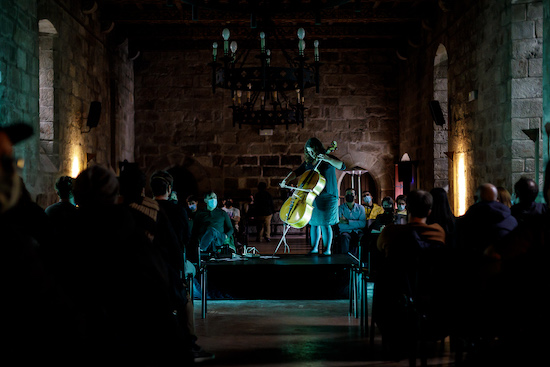Yvette Janine Jackson and Judith Hamann
“I struggle with the idea that experimentation is just about newness and discovery, to me that’s tied to a colonial approach to music making,” says Judith Hamann, the Australian cellist speaking in a panel with Yvette Janine Jackson and journalist Rui Miguel Abreu, ahead of her and Jackson’s three-hour durational piece commissioned for this year’s Semibreve festival in Braga, Portugal.
“I’m interested in uncovering and going deeper into things. Developing a new relationship with an instrument, rather than coming from a place of mastery or virtuosity. For instance, treating the cello as a non-human collaborator. Uncovering something together rather than imposing it on the instrument, the audience, the space or the performer – getting away from that master framework.”
She mentions Alvin Lucier and Sarah Hennies as composers who work in this way, and although neither of those two are appearing at Semibreve 2021, the themes Hamann mentions could be taken as a leitmotif for the festival. Throughout there’s a sense of gentle interrogation, ideas developing through conversation, and a reframing of tradition. Hamann says: “It’s about being more generative and less antagonistic.” She’s talking about her own work, but it fits with Semibreve 2021 as a whole.
Jackson and Hamann’s performance, in the medieval salon at the University of Minho, seems driven by a strive to decentre – even though the main visual element is Hamann bowing a cello on a podium in the middle of the room. As she plays, she gradually rotates around while a dramatically panned, constantly evolving soundtrack prepared by Jackson is played toward the centre of the room from four speakers. Sparse drum beats with individual hits spread across the quadrophonic field, and barely there drones levitate on the cusp of perception.
The effect is something like a Grand Orrery model of spinning cogs and orbits – the movement of Hamann and the audio in the speakers hooking the audience into this elaborate spinning contraption and putting the connections between all three into a state of motion. The lack of linearity or a centralised focal point feels like a reflection on interdependence, as if Jackson and Hamann are gently twisting rigid performer, venue, and audience structures to reveal the fluid relationships and interactions which underpin them.
While Jackson and Hamann explore relations between humans and spaces, across town in the Black Box (a venue which looks exactly as its name suggests) at Gnration, Porto-based AG.R97 push the conversations between humans and technology for their performance in the Turva label showcase.
The three-piece, with one member on drums and heavily fx’d vocals, one on xylophone, and one jumping between fretless bass and electronics, mix the synthetic and the analogue with remarkable fluidity. Their set ranges from beautiful AutoTuned soul balladry through an almost post rock heft with jazz fusion inflected digital textures, computer generated arpeggios and pads mixing seamlessly into picked bass strings and rolling drums. It’s a thrilling performance where the digital and the acoustic gel together effortlessly, triumphantly dissolving the boundary between the two so something new emerges in the overlap.
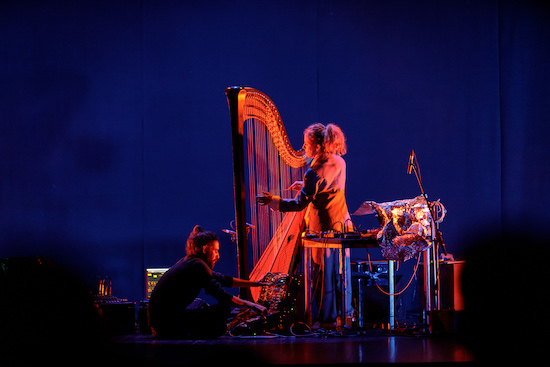
Zeena Parkins and André Gonçalves
Rewinding back to Friday, Zeena Parkins and André Gonçalves‘ set in the Theatre Circo is preceded by an awe-inspiring deluge of a storm. And the duo begin with a gorgeous tapestry of intricate electro-acoustics which I’d have no qualms in believing was triggered by rain water dripping through the beams and cracks of the theatre. I’ve spent the last 18 months only listening to electro-acoustic music on headphones, and I’d completely forgotten what it’s like to hear it played out loud on big speakers in the company of others. The strange curiosity of wondering if everyone in the room is hearing it the same way as you.
For huge swathes of the set Parkins’ harp seems more like a prop, as she barely touches it apart from odd scrape or solitary pluck, her focus instead on a spread of electronics and an intriguing wrap of foil hanging from her table. Even in the performance’s most celestial moment, which has Parkins slide into twinkling strums, it never escapes the glitch, that instant of touching on the instrument’s more traditional usage seeming to agitate Gonçalves into pulling the other way. At the same time, the harp’s presence can’t help but bring along some of the sacred histories layered in it to the electronic textures and snips of radio interference. It results in a delirious tension, a conversation between traditions held in a state of suspension. Like AG.R97, they find new possibilities by staying in those overlaps.
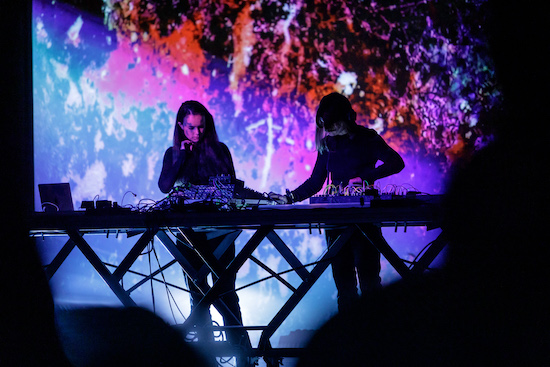
Klara Lewis & Nik Void and Pedro Maia
This twisting of familiarity isn’t restricted to how artists interact with their instruments, it’s also in how they interact with the venues themselves. Following Parkins and Gonçalves come Klara Lewis and Nik Void, accompanied by a stunning visual display from Pedro Maia. The set opens with violence, vicious strobes blinding through a barrage of intense distortion. While subsiding a little from that pummelling intensity, they stay firmly rooted in the realm of the brutal.
It seems gloriously at odds with the genteel grandeur of the venue, with its classy red furnishings and immense chandelier. Portugal’s Covid restrictions mean no one can dance to this, we’re all stuck in our chairs. And that leads to the disorientating effect of absorbing intensely physical music while having your bodily response restricted. This space was not designed for this type of ferocity. But as Lewis and Void close with a stuttered cut up of an AutoTuned vocal looping on in awkward ecstasy, I find myself looking at the building’s ornate ceiling and thinking that the trio have affected the theatre as much as it’s affected them.
While it’s harder to surrender to the physicality, there’s more space to focus on the nuance – the strange sonic and visual details that appear in the A/V tumult they unleash. This isn’t the first time that something this physical has appeared in a venue this regal – it seems quite a common curatorial choice in experimental festivals around Europe. But rather than feeling like a battle where either the artists overcome the venue, or the venue ends up diluting the effect of the music, Lewis, Maia, Void and the Theatre Circo all seem to rewire each other.
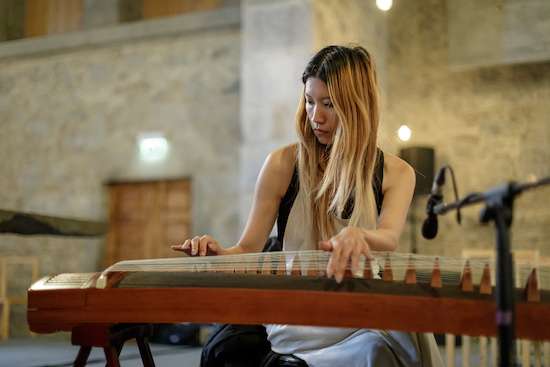
Flora Yin-Wong
Flora Yin-Wong pulls a similar trick the following day, with a durational piece, Sea Of Fertility, performed in the majestic The Capela Imaculada do Seminário Menor, a chapel on the outskirts of the city.
The building is mostly lit by light bulbs, with the exception of a solitary candle. A point of flickering light against the static electrical illumination. Solid beams of light criss-cross the vaulted ceiling of the church, with one fluctuating exception. I’m not a lighting engineer, so I can’t tell if this is connected to the candle or a coincidence. But these relations of stasis and flux provide a useful metaphor for how Yin-Wong’s composition diffuses through the room.
Using electronics and a guzheng, the piece revolves around flurries of activity as she sets sounds in motion, before contemplation as the compositions are left to emerge and evolve through the hall.
It ends up creating a surreal contrast with the fixed monolith of the church. Although slabs of stretched choral samples and swarms of static underpin the piece, fragments of frantic movement and snaps of beats occasionally float through the haze. Rather than simply try to fill the church with audio, the composition manages to generate its own flows of time and space within the walls. As with Lewis, Void and Maia, and Hamann and Jackson, there’s a real sense of Yin-Wong engaging with the space and pursuing what emerges from the interaction.

Laurel Halo and Oliver Coates
New and rekindled collaborations are a recurring theme of this edition of Semibreve, and in our still pandemic afflicted times it has special poignancy. Like so many festivals, Semibreve 2021 was in doubt until late on, and the form it takes has been altered to reflect the new normal, as that ever shifting new normal currently stands. Tied in with sonic exploration, the festival seems undercut by the sense of reconnecting.
After 18 months of in-person collaborations being rendered impossible, or at least more obstructed than usual, it feels like the way we connect and communicate should perhaps not be taken for granted. The collaborations at Semibreve shine a light on that with particular clarity, it feels like the dynamics between artists has become as interesting as the end result.
With Laurel Halo and Oliver Coates, that dynamic seems a particularly serene one. Solo, both artists have covered a diverse range of sonics, and it was hard to predict what they were going to deliver in Braga. Perhaps unsurprisingly, it seems like an expansion on what they started to explore in the two tracks featuring Coates on Halo’s 2018 release, Raw Silk Uncut Wood.
They’re unafraid to stick to woozy, cinematic vistas, a bold move to stay with sweetness and romance in the context of a festival dominated by artists pushing to abstraction. The performance feels like a recital, yet for all the harmony and grace, the duo manage to avoid falling into cloying cliches. The reason this works so well is that instead of trying to compensate for the lack of moving images by overburdening the music, they toy with the hole left behind. That gap allowing cinematic tropes to slip from background to foreground.
Coates’ cello playing sounds luminous, occasionally fired through effects to build heavenly overtones, looped or gently distorted. Halo’s contribution is marked by exquisite restraint, largely sticking to the piano, she leaves acres of space, meaning every flurry, twinkle or bass run hits like a ray of light into a pitch black room. The set moves from aching counterpoints through gentle electronic pads and into a dramatic spectral swarm verging on Ligeti territory. It feels like a collaboration built on understanding between the pair. Two minds thinking alike – the musical equivalent of two people finishing each other’s sentences.
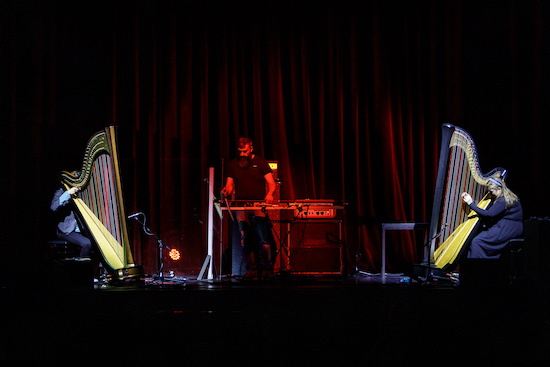
Rabih Beaini, Angélica Salvi and Eleonor Picas
But of course, sometimes you need tension, and the trio of Rabih Beaini, Angélica Salvi and Eleonor Picas has that in abundance. Picas and Salvi both play harps, while Beaini is on vocals and a customised instrument which is strung with a motorcycle clutch cable and plugged into a bass stack.
The set begins with Salvi and Picas in a delicate call and response. It seems an age before Beaini enters, arriving with intense, droning vocalisations. It acts as a catalyst, seemingly pushing the harps to de-latch from each other and break into stranger forms. Beaini attacks the stringed instrument with a bow and drum stick, walls of crunch-warped tones flinging out in sharp juxtapositions with the harps. These provocations spread, all three members nudging and challenging each other in their fierce, volatile improvisation.
The tension never feels aggressive or reduced to a tedious game of devil’s advocate. Instead, the three players challenge each other into new zones. A demonstration that innovation comes from working through disagreement and dissonance as much as unison.
Words like exploratory and experimental get thrown around a lot, to the extent they can start to lose any meaning. Semibreve 2021’s curation excels by catching experimentation in flight rather than trying to pin it down. An open-ended questioning of spaces, tools and the people involved, whether on stage or in the audience. A dynamic, ever evolving, open ended conversation which shifts the frame, alters preconceptions, and fires off in multiple dimensions in defiance of linear ideas of the way forward.

